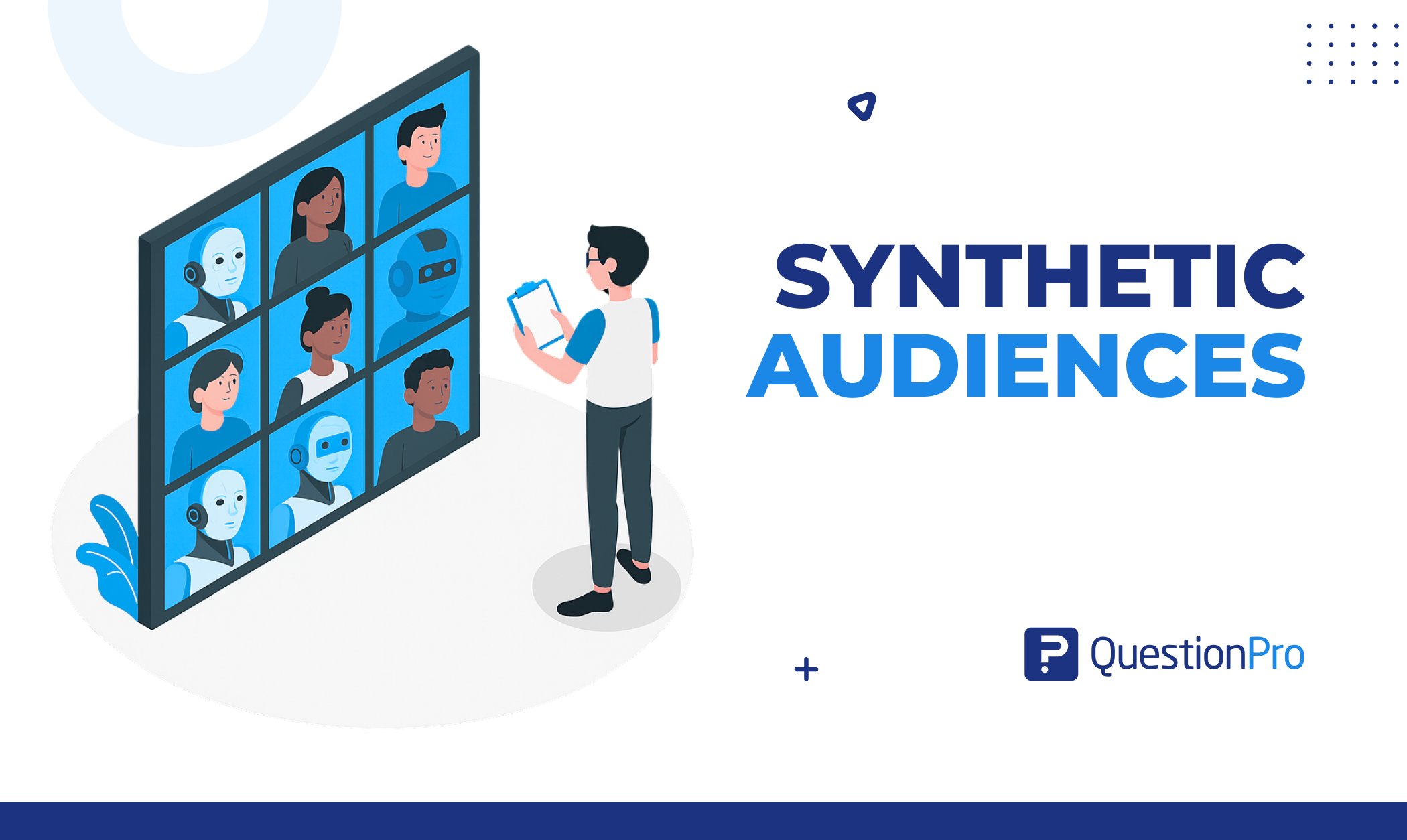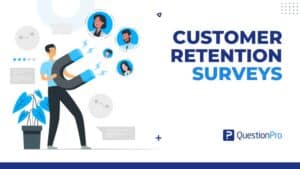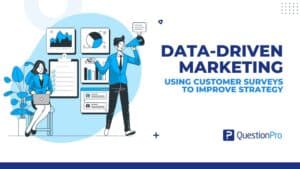
What if you could predict how your customers will respond without sending a single real-world survey? That’s exactly what synthetic audiences make possible. These AI-generated populations mirror real customer segments, allowing you to test messages, product ideas, or experiences through data simulations instead of traditional surveys.
By simulating behavior that closely resembles actual consumer responses, synthetic audiences give researchers and marketers the ability to run faster, more cost-effective tests. Whether it’s refining your survey logic, exploring product-market fit, or forecasting reactions before launch, this technology is transforming how insights are gathered.
In this blog, we’ll explore how this tool works, why it’s becoming essential in modern research, and how you can start using it to make smarter, data-driven decisions.
What Are Synthetic Audiences?
Synthetic audiences are AI-generated groups that represent real customer segments without involving real people. Built through advanced data modeling, they reflect behaviors, preferences, and demographics using large-scale datasets.
Instead of relying on time-consuming surveys, you can use these simulations to predict how customers might respond to your messaging, product ideas, or experiences. This makes them especially useful for early-stage testing and forecasting.
With the help of AI and machine learning, you can create realistic virtual personas by analyzing patterns in past survey responses, online activity, and purchase behavior. These tools allow you to run fast, scalable experiments and make informed decisions without the need for live participants.
Why Use Synthetic Audiences in Research?
Running traditional surveys takes time, money, and effort, from finding the right participants to getting them to actually respond. Synthetic audiences offer a faster, more flexible alternative that helps research teams test ideas quickly and reduce the stress of lengthy survey cycles.
1. Solving Challenges in Traditional Sampling
Recruiting participants can be slow and expensive. Low response rates, panel fatigue, and the need for incentives add to the challenge. Even building a sample that truly reflects your target audience can be difficult.
This is where synthetic audiences come in. They remove these burdens by providing ready-made, data-driven groups that align with your research goals.
2. Overcoming Bias, Cost, and Time Barriers
Because they are built from clean, structured data, these simulated groups avoid common pitfalls like self-selection bias and survey fatigue. You also save time and money by:
- Skipping recruitment and incentives
- Eliminating panel management
- Reusing audience models across studies
What used to take weeks can now be done in minutes.
3. Faster Hypothesis Testing Without Field Deployment
You can instantly test concepts, messages, or pricing strategies without launching full-scale fieldwork. This speed lets you iterate, validate early ideas, and fine-tune campaigns long before committing resources.
4. Accessing Hard-to-Reach or Sensitive Segments
Reaching certain groups, such as affluent consumers or individuals in highly regulated industries, can be challenging through surveys. With synthetic audiences, you can gain insights from these segments ethically and efficiently.
By removing traditional roadblocks, synthetic audiences are reshaping how research is done. They empower teams to explore more, act faster, and reach the right people with greater precision.
How Synthetic Audiences Are Created?
Creating synthetic audiences isn’t about guessing; it’s a data-driven process that uses AI and real-world information to build realistic, virtual personas. These models help researchers simulate audience or consumer behavior without needing live respondents.
Here’s how it works:
- Data Modeling from Real-World Sources: It all starts with actual data survey responses, purchase behavior, online activity, and more. This information is structured and analyzed to reveal patterns that can be used to build virtual versions of real audience segments.
- Machine Learning and Generative AI: Once the data is in place, AI takes over. Machine learning algorithms and generative models are used to create lifelike personas that reflect how different types of people might think, feel, or act in specific situations.
- Demographic and Psychographic Mapping: To make these personas useful, the models include key traits like age, gender, location, interests, attitudes, and values. This helps ensure the synthetic audience feels real and relevant to the research goal.
- Behavioral Pattern Simulation: AI doesn’t just replicate who people are; it predicts what they do. Models simulate how a persona might react to an ad, respond to a product, or engage with a brand, helping teams test strategies before launch.
- Continuous Model Refinement: As new data becomes available, these artificially created audiences can be updated and refined. This keeps them aligned with current trends and real-world shifts, making them a reliable tool over time.
Fake audiences are only as good as the data and modeling behind them. But when built correctly, they offer a powerful way to explore customer behavior and test ideas fast, affordably, and at scale.
Applications of Synthetic Audiences in Survey Research
Synthetic audiences aren’t just a futuristic concept; they’re already being used in practical, everyday research. By simulating how real people might respond, they help teams move faster and make better decisions without waiting for fieldwork.

Pre-testing survey designs
Before launching a survey, researchers can run it through a synthetic audience to catch confusing wording, logic issues, or biased phrasing. It’s like getting a second opinion instantly and risk-free.
- Spot unclear or leading questions.
- Test survey flow and logic.
- Identify potential drop-off points.
Running simulations for market segmentation
Synthetic audiences make it easy to explore how different types of customers might respond to a product, ad, or offer. Instead of recruiting people for every segment, you can simulate responses from a variety of modeled groups. This allows you to:
- Model different segments.
- Test by demographics.
It’s a quick, flexible way to test ideas before investing in full-scale research.
Forecasting product adoption or behavior trends
Curious how your target audience might respond to a new product or message?
These virtual audiences help you predict reactions and spot potential challenges before going live.
Fake audiences make it easier to test, tweak, and fine-tune your research. Whether you’re shaping survey questions or exploring new markets, they offer a smart shortcut to insights, no waiting required.
Benefits of Using Synthetic Audiences
Synthetic audiences give researchers a powerful way to test ideas, refine marketing strategies, and gather insights quickly and efficiently. They remove many of the common roadblocks in traditional research while offering more flexibility and scale.
- Without the need for recruitment or incentives, fake audiences make it easier to run studies on tight budgets and timelines.
- Since these audiences are virtual, you can test as often as needed without worrying about respondent burnout.
- Synthetic data helps train and improve AI models by providing large, controlled datasets that mirror real-world behavior.
- You can model niche or hard-to-reach audiences like high-income consumers or specialized professionals without the usual recruitment challenges.
- Once built, these kinds of audiences can be reused across multiple projects, ensuring consistency in testing and insights over time.
- Synthetic audiences let you test more, learn faster, and spend less, all without compromising on quality.
How QuestionPro Advances Synthetic Audiences?
Synthetic audiences offer a smarter, safer way to test ideas. QuestionPro Research Suite brings this innovation to life, helping researchers move quickly, ethically, and with confidence. From simulating responses to niche targeting, we make synthetic audience research practical and powerful.

- Pre-Test Surveys Instantly
Simulate thousands of virtual responses before launching a real study. With QuestionPro, you can fine-tune your survey design, identify biased questions, and predict how real people might respond without spending on a pilot.
- Stress-Test Strategies Risk-Free
Wondering how your audience will react to a price hike or policy change?
With these fake audiences that behave like real people, you can explore “what if” scenarios safely before rolling anything out in the real world.
- Integrating Synthetic Panels into Survey Workflows
QuestionPro makes it easy to bring artificially created audiences directly into your survey workflows. You can blend synthetic responses with live data or run simulations independently, giving you full flexibility.
- Enhancing Conjoint, MaxDiff, and VoC Simulations
Whether you’re running conjoint analysis, MaxDiff tests, or VoC programs, fake audiences help you simulate trade-offs and preferences more efficiently. You’ll get faster results without compromising quality.
With QuestionPro, synthetic audiences become more than just a research tool; they become part of a smarter, more agile strategy. You can test bold ideas, move faster, and stay compliant, all while keeping privacy and innovation at the core of your research process.
Considerations and Limitations of Synthetic Audiences
While fake audiences give you speed and scale, they come with responsibilities. Ethical research means knowing how these models are built, how they’re used, and where they fall short. Here’s what to consider:
1. Transparency in Audience Modeling
To build trust and ensure the ethical use of synthetic audiences, researchers should be transparent about how these audiences are created. Share the details, and stakeholders will understand the context and limitations of the results.
- Key points to share:
- What data sources were used?
- How were the models trained?
- What assumptions or constraints were applied?
This level of openness makes it easier for others to interpret findings responsibly and confidently.
2. Limitations of Simulated Behavior
Synthetic audiences can mimic real-world patterns but can’t replicate human emotion, spontaneity, or cultural nuance. They’re great for testing hypotheses, not all types of qualitative research or live research.
3. Responsible Research Practices
Use synthetic datasets for ethical research in ways that align with:
- Privacy standards.
- Don’t reinforce bias.
- Stay true to the intent.
Responsible use means regular auditing of models and understanding the real-world impact.
These audiences are awesome, but should always be used with clarity, caution, and care. Be transparent and thoughtful, and you can get value from simulations without compromising integrity.
Conclusion
Synthetic audiences are more than just a trend; they’re transforming the way research is done. By simulating real-world behavior using AI and data modeling, they allow researchers to test ideas, refine strategies, and gather insights without the time, cost, or privacy challenges of traditional sampling. In this article, we discuss the new era of artificially created audiences, their work, and their challenges.
In QuestionPro, the Research Suite lets you simulate audience interactions, model niche segments, and integrate synthetic panels directly into your workflow. Whether you’re running VoC programs, conjoint analysis, or survey tests, QuestionPro gives you the tools to apply synthetic audiences responsibly and effectively so you can make smart decisions, faster.
Frequently Asked Questions (FAQs)
Answer: Unlike traditional survey samples that rely on real participants, synthetic audiences are built from existing data patterns. They’re faster, more scalable, and don’t require incentives or recruitment.
Answer: They’re built using real-world data (like purchase behavior, survey history), machine learning algorithms, and demographic/psychographic mapping to simulate realistic personas and behaviors.
Answer: Yes! You can use synthetic audiences to pre-test survey designs, spot unclear questions, improve logic, and reduce bias without running a costly pilot.
Answer: Transparency in how audiences are modeled, understanding their limitations, and regular auditing are key to maintaining responsible use.
Answer: QuestionPro Research Suite enables users to simulate responses, model niche segments, integrate synthetic data into workflows, and run advanced simulations, all while maintaining compliance and flexibility.







